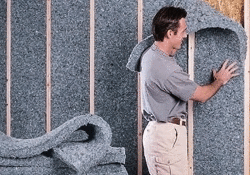FIXING AND PASTING WALL PAPERS

If rooms were perfectly regular, with straight walls and true corners, wallpapering would be easy. To ensure tha t the paper hangs straight, even if the walls are not, it is important to use a plumbline to get the first drop straight and to correct any errors that creep in when you take the paper around corners. Normally, start hanging wallpaper near the door, or any full-height obstruction, so that when you get back to the starting point, any mismatch will be less obvious. With bold patterns, hang the first drop so that it is centred 011 the focal point of the room, such as the chimney breast. You will need a plumbline (or weight tied to a piece of string), chalk, a bucket and wide pasting brush, a pasting table or suitable surface at least 55 ern (21 in) wide and 1.5 m (5 ft) long, a wallpaper smoothing brush, a pair of long-bladed scissors, a smaller pair of seissors, a trimming knife and a seam roller. Wallpaper comes in standard-sized rolls, 53 ern (21 in) by 10 m (11 yd). To work out how much you need see page 212. Wallpaper paste is available in powder form or ready mixed. The powder form is more economical, easier to use, and provides a good bond for normal papers and vinyl wallcover- ings. Always choose a paste containing a fungicide when hanging vinyls. 1. Mix the paste, following the instructions on the packet. Measure up and cut the first drop, allowing at least 10cm (4in) extra for trimming. Cover the plumbline with chalk, hang it at your starting point and hold the weight in place while you snap the chalked line against the wall. 2. Lay the paper on the pasting table, wrong side up, with one edge of the paper aligned with the edge of the table and the top aligned with one end of the table. This prevents paste getting on the ta ble and spread- ing on the right side of the wallpaper. Apply the paste, working towards the matched edge down the length of the table. Then shift the paper so the other edge matches the other edge of the table, and apply the paste working out the other way. 3. Ensure the whole strip is evenly covered. When you need to move the paper down the table, fold over the pasted end in an S shape. Apply paste to the other end of the drop in the same way, then fold up the lower end of the paper. Leave the paper to rest according to the manufacturer's instructions so the paste soaks in. 4. Carry the pasted paper to the wall, draped over your arm. Hold it up to the wall so that the top is 5 em (2 in) above the edge of the cornice or picture rail and one edge matches the plumbed line. Gradually unfold the paper, smoothing it down with a smoothing brush as you go. Do not apply too much pressure as this might stretch the paper. A void getting any paste on the right side of the paper. If bubbles and wrinkles appear, lift the paper away from the wall beyond the fault, and smooth down again. Apply extra paste to the wall if necessary. Try not to stretch the paper as you lift and re-position it. 5. When the whole drop is in place, mark the cutting line at the top by drawing the back of the scissors along the angle between the cornice or picture rail and the wall. Peel the paper back from the wall slightly and trim along the marked line, or trim with a sharp trimming knife while it is still in position. Repeat at the skirting. 6. Cut subsequent drops, allowing extra for pattern matching if necessary. Always start to paste at the top of the drop, and hang from the top, aligning the pattern carefully. This will be easier if you identify bold ele- ments of the pattern which fall at the seam line before you start. Run the seam roller down the seams to ensure they are well stuck down. 7. At internal corners, cut down the length of the drop to make a strip 2.5 ern (1 in) wider than the distance to the corner. Hang this strip, wrapping it around the corner and cutting into the overlap if necessary to ac- commodate any bulges. Then mark a new vertical around the corner, and paste and hang the strip you cut off the drop, overlapping the latter slightly. Use the same technique to wrap pa per around external corners. 8. When wallpapering around an obstacle, pa per up to it, then cu t in to the pa per to release it, clipping diagonally to any angles or radially around circular obstructions. Turn the power off at the mains before papering around electric swi tchcs and fittings. Then you can trim the paper roughly to fit, unscrew the fitting slightly and tuck the edges under the faceplate. When fitting paper around large obstacles such as doors or windows, cut away waste paper to make it easier to handle. 9. If there are air bubbles behind the paper which you have missed, use a sharp trimming knife to cut a cross into the bubble. Peel the four triangular flaps back from the wall and apply more paste to the wall. Smooth the flaps back in place, wiping off excess glue and running over the cuts with a seam roller. The paper will take a day or so to dry out- longer if it has a vinyl surface. Do not worry about patchiness when you first hang the paper: this is caused by the paste, and should disappear as the paper dries out.